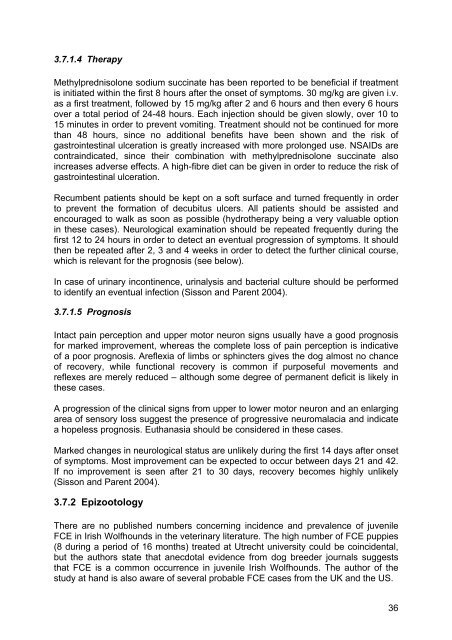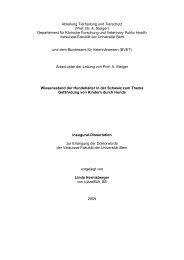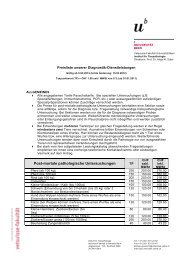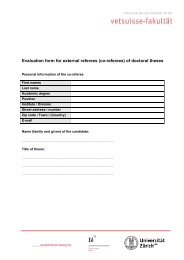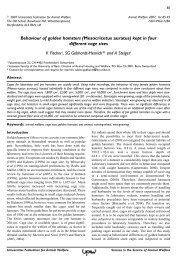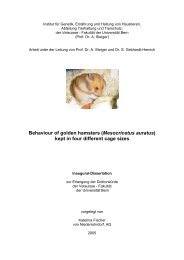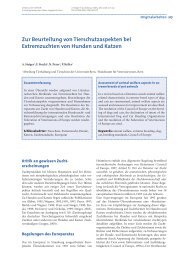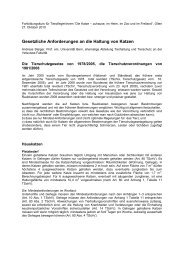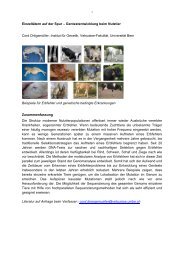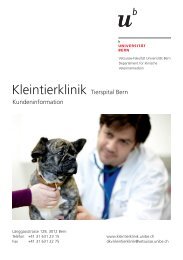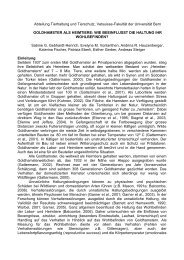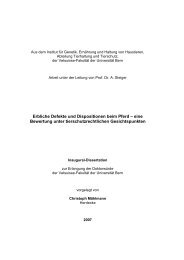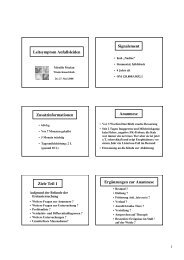Lifespan and Causes of Death in the Irish Wolfhound - Vetsuisse ...
Lifespan and Causes of Death in the Irish Wolfhound - Vetsuisse ...
Lifespan and Causes of Death in the Irish Wolfhound - Vetsuisse ...
Create successful ePaper yourself
Turn your PDF publications into a flip-book with our unique Google optimized e-Paper software.
3.7.1.4 Therapy<br />
Methylprednisolone sodium succ<strong>in</strong>ate has been reported to be beneficial if treatment<br />
is <strong>in</strong>itiated with<strong>in</strong> <strong>the</strong> first 8 hours after <strong>the</strong> onset <strong>of</strong> symptoms. 30 mg/kg are given i.v.<br />
as a first treatment, followed by 15 mg/kg after 2 <strong>and</strong> 6 hours <strong>and</strong> <strong>the</strong>n every 6 hours<br />
over a total period <strong>of</strong> 24-48 hours. Each <strong>in</strong>jection should be given slowly, over 10 to<br />
15 m<strong>in</strong>utes <strong>in</strong> order to prevent vomit<strong>in</strong>g. Treatment should not be cont<strong>in</strong>ued for more<br />
than 48 hours, s<strong>in</strong>ce no additional benefits have been shown <strong>and</strong> <strong>the</strong> risk <strong>of</strong><br />
gastro<strong>in</strong>test<strong>in</strong>al ulceration is greatly <strong>in</strong>creased with more prolonged use. NSAIDs are<br />
contra<strong>in</strong>dicated, s<strong>in</strong>ce <strong>the</strong>ir comb<strong>in</strong>ation with methylprednisolone succ<strong>in</strong>ate also<br />
<strong>in</strong>creases adverse effects. A high-fibre diet can be given <strong>in</strong> order to reduce <strong>the</strong> risk <strong>of</strong><br />
gastro<strong>in</strong>test<strong>in</strong>al ulceration.<br />
Recumbent patients should be kept on a s<strong>of</strong>t surface <strong>and</strong> turned frequently <strong>in</strong> order<br />
to prevent <strong>the</strong> formation <strong>of</strong> decubitus ulcers. All patients should be assisted <strong>and</strong><br />
encouraged to walk as soon as possible (hydro<strong>the</strong>rapy be<strong>in</strong>g a very valuable option<br />
<strong>in</strong> <strong>the</strong>se cases). Neurological exam<strong>in</strong>ation should be repeated frequently dur<strong>in</strong>g <strong>the</strong><br />
first 12 to 24 hours <strong>in</strong> order to detect an eventual progression <strong>of</strong> symptoms. It should<br />
<strong>the</strong>n be repeated after 2, 3 <strong>and</strong> 4 weeks <strong>in</strong> order to detect <strong>the</strong> fur<strong>the</strong>r cl<strong>in</strong>ical course,<br />
which is relevant for <strong>the</strong> prognosis (see below).<br />
In case <strong>of</strong> ur<strong>in</strong>ary <strong>in</strong>cont<strong>in</strong>ence, ur<strong>in</strong>alysis <strong>and</strong> bacterial culture should be performed<br />
to identify an eventual <strong>in</strong>fection (Sisson <strong>and</strong> Parent 2004).<br />
3.7.1.5 Prognosis<br />
Intact pa<strong>in</strong> perception <strong>and</strong> upper motor neuron signs usually have a good prognosis<br />
for marked improvement, whereas <strong>the</strong> complete loss <strong>of</strong> pa<strong>in</strong> perception is <strong>in</strong>dicative<br />
<strong>of</strong> a poor prognosis. Areflexia <strong>of</strong> limbs or sph<strong>in</strong>cters gives <strong>the</strong> dog almost no chance<br />
<strong>of</strong> recovery, while functional recovery is common if purposeful movements <strong>and</strong><br />
reflexes are merely reduced – although some degree <strong>of</strong> permanent deficit is likely <strong>in</strong><br />
<strong>the</strong>se cases.<br />
A progression <strong>of</strong> <strong>the</strong> cl<strong>in</strong>ical signs from upper to lower motor neuron <strong>and</strong> an enlarg<strong>in</strong>g<br />
area <strong>of</strong> sensory loss suggest <strong>the</strong> presence <strong>of</strong> progressive neuromalacia <strong>and</strong> <strong>in</strong>dicate<br />
a hopeless prognosis. Euthanasia should be considered <strong>in</strong> <strong>the</strong>se cases.<br />
Marked changes <strong>in</strong> neurological status are unlikely dur<strong>in</strong>g <strong>the</strong> first 14 days after onset<br />
<strong>of</strong> symptoms. Most improvement can be expected to occur between days 21 <strong>and</strong> 42.<br />
If no improvement is seen after 21 to 30 days, recovery becomes highly unlikely<br />
(Sisson <strong>and</strong> Parent 2004).<br />
3.7.2 Epizootology<br />
There are no published numbers concern<strong>in</strong>g <strong>in</strong>cidence <strong>and</strong> prevalence <strong>of</strong> juvenile<br />
FCE <strong>in</strong> <strong>Irish</strong> <strong>Wolfhound</strong>s <strong>in</strong> <strong>the</strong> veter<strong>in</strong>ary literature. The high number <strong>of</strong> FCE puppies<br />
(8 dur<strong>in</strong>g a period <strong>of</strong> 16 months) treated at Utrecht university could be co<strong>in</strong>cidental,<br />
but <strong>the</strong> authors state that anecdotal evidence from dog breeder journals suggests<br />
that FCE is a common occurrence <strong>in</strong> juvenile <strong>Irish</strong> <strong>Wolfhound</strong>s. The author <strong>of</strong> <strong>the</strong><br />
study at h<strong>and</strong> is also aware <strong>of</strong> several probable FCE cases from <strong>the</strong> UK <strong>and</strong> <strong>the</strong> US.<br />
36


